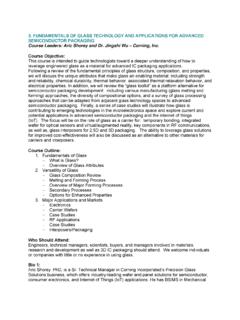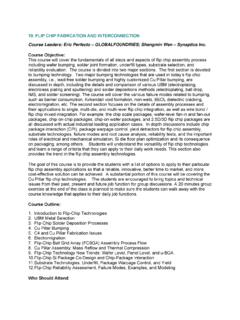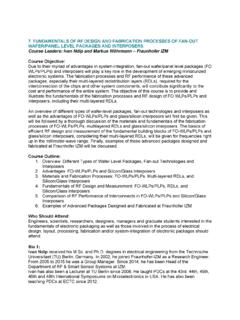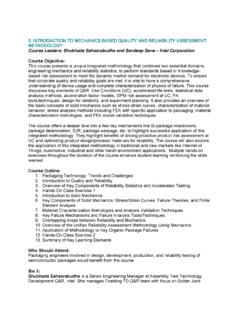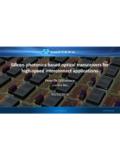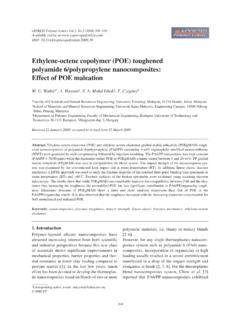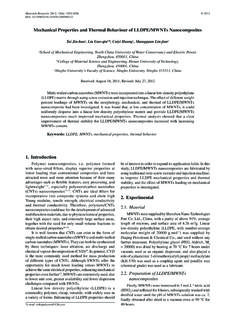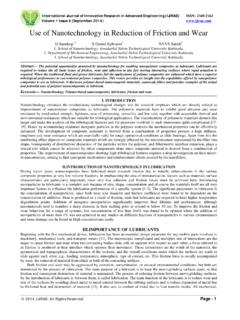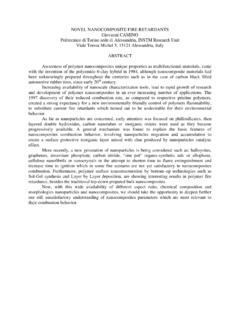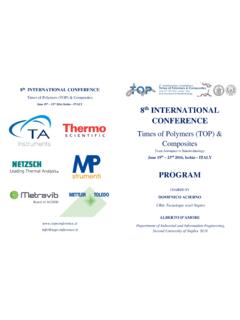Transcription of 2018 PDC 6 CP Wong and Daniel Lu - ECTC
1 6. POLYMERS AND nanocomposites FOR ELECTRONIC AND PHOTONIC. PACKAGING. Course Leaders: C. P. Wong Georgia Institute of Technology; Daniel Lu Henkel Corporation Course Objective: Polymers and nanocomposites are widely used in electronic and photonic packaging as adhesives, encapsulants, insulators, dielectrics, molding compounds and conducting elements for interconnects. These materials also play a critical role in the recent advances of low-cost, high performance novel no flow underfills, reworkable underfills for ball grid array (BGA), chip scale packaging (CSP), system in a package (SIP), direct chip attach (DCA), flip-chip (FC), paper-thin IC and 3D packaging, conductive adhesives (both ICA and ACA), embedded passives (high K polymer composites), nano particles and nano functional materials such as CNTs (some with graphenes). It is imperative that both material suppliers, formulators and their users have a thorough understanding of polymeric materials and the recent advances on nano materials and their importance in the advances of the electronic packaging and interconnect technologies.
2 Course Outline: 1. Fundamental of Polymers and Materials Science and Engineering 2. Material Needs for Next Generation Electronic Packaging 3. Novel nanocomposites for Flip-Chip Underfill Applications 4. Recent Advances on Nano Lead-Free Alloys for High Performance Components Interconnects 5. Low-Cost High Performance Lead-Free Interconnect Materials and Processes 6. Recent Advances on CNTs as Thermal Interface Materials (TIMs). 7. Lotus Effect Coating for Self-Cleaning Applications 8. Fundamentals of Electrically Conductive Adhesives (ECAs). 9. Recent Advances on Conductive Adhesives 10. Recent Advances on Nano Conductive Adhesives Who Should Attend: Engineers, scientists and managers involved in designing, processing and manufacturing of microelectronic and optoelectronic components and packages, material suppliers, and students and researchers on electronic packaging should attend. Bio 1: Prof. C. P. Wong is currently Dean of the Faculty of Engineering at the Chinese University of Hong Kong.
3 He is on a no pay long leave from Georgia Institute of Technology (GT) where he is a Regents' Professor and the Charles Smithgall Institute Endowed Chair at the School of Materials Science and Engineering He received his degree from Purdue University, and his degree from the Pennsylvania State University. After his doctoral study, he was awarded a two-year postdoctoral fellowship with Nobel Laureate Professor Henry Taube at Stanford University. Prior to joining GT in 1996, he was with AT&T Bell Laboratories for many years and became an AT&T Bell Laboratories Fellow in 1992 for his seminal contributions to low-cost high- performance packaging of semiconductor devices and components. His research interests lie in the fields of polymeric electronic materials, electronic, photonic and MEMS packaging and interconnect, interfacial adhesions, nano-functional material syntheses and characterizations, nano-composites such as well-aligned carbon nanotubes, graphenes, lead-free alloys, flip chip underfill, ultra high k capacitor composites and novel lotus effect coating materials.
4 He received many awards, among those, the AT&T Bell Labs Fellow Award in 1992(the most prestigious Technical Award bestowed by Bell Labs), the IEEE Components, Packaging and Manufacturing Technology (CPMT) Society Outstanding Sustained Technical Contributions Award in 1995, the IEEE Third Millennium Medal in 2000, the IEEE Educational Activity Board(EAB) Outstanding Education Award in 2001, the IEEE CPMT Society Exceptional Technical Contributions Award in 2002, the Georgia Tech Class 1934 Distinguished Professor Award(the highest Award bestowed by GT to the faculty) in 2004, named holder of the Charles Smithgall Chair(one of the two GT Institute-Endowed Chairs) in 2005, the GT Outstanding PhD. Thesis Advisor Award, the IEEE Components, Packaging and Manufacturing Technology Field Award in 2006(hailed as Father of Modern Semiconductor Packaging ), the Sigma Xi's Monie Ferst Outstanding Educational Award in 2007, the Society of Manufacturing Engineers' Total Excellence in Electronic Manufacturing Award in 2008 and the IEEE CPMT David Feldman Award in 2009.
5 He holds over 50 patents, and has published over 1,000 technical papers, co-authored and edited 10 books and is a member of the National Academy of Engineering of the USA since 2000. Bio2;. Dr. Daniel Lu is the Vice President of Product Development and Technical Customer Service of the Henkel Corporation in Asia Pacific. Prior to joining Henkel, he worked for the R&D. department of Intel Corp (AZ, USA), as a Sr. Scientist for 7 years. He also had worked for Lucent Technologies, Amoco's Electronics Materials Division, and the Electronics Materials Group of National Starch and Chemical Company before. He has extensive experience in electronic packaging especially on materials and processing. He received his MS and PhD. degrees on Polymer Science and Engineering from Georgia Institute of Technology in 1996 and 2000, respectively. Dr. Lu received many awards including the IEEE/CPMT Outstanding Young Engineer Award in 2004, the IEEE ECTC best poster paper in 2007, Intel's most patent filing in 2003-2007, Intel Divisional Recognition Awards in 2002, 2003, and 2007, Intel most patent granting of the year for 2006 and 2007.
6 Dr. Lu has published more than 50 technical papers, wrote chapters for five books, and holds more than 80 US patents. He is the editor of the book Materials for Advanced Packaging (2008) and co-author of the book Electronically Conductive Adhesives with Nanotechnologies (2009) . He has been serving key roles in organizing international electronic packaging conferences and teaching professional development short courses in these conferences. Dr. Lu is a senior member of IEEE, and an associate editor of IEEE Transactions on Advanced Packaging and Journal of Nanomaterials, and an editorial board member of Nanoscience & Nanotechnology-Asia. Dr. Lu is a member of CMPT Board of Governor Member-at-large.


